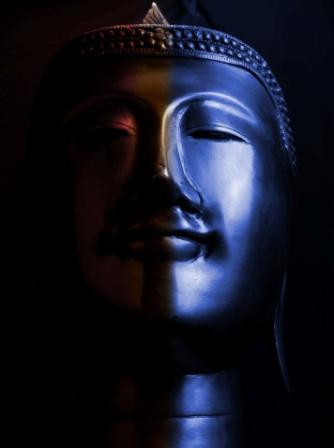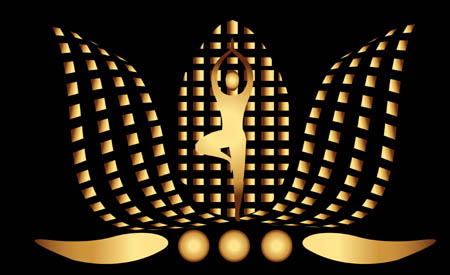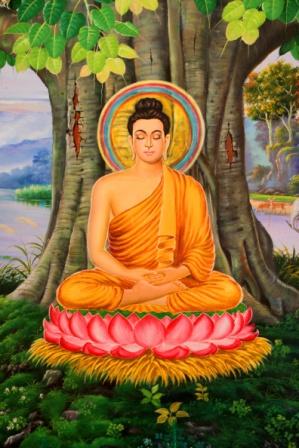Moksha – The Ultimate Spiritual Liberation

By Dr Raghuram Y.S. MD (Ay) & Dr Manasa, B.A.M.S
Moksha means liberation. Moksha is one among the four goals of life called Purushartha Chatushtaya. It is explained in Hindu philosophies and ancient Indian treatises including the Upanishads, Vedas and epics like Ramayana and Mahabharata. The other pursuits are Dharma (righteousness), Artha (ethical earning) and Kama (pleasure obtained in ethical way).
Read – Artha – Pursuit For Ethical Earning, Money, Wealth
The word Moksha is derived from the root Sanskrit term ‘much’. It means ‘to be free’, ‘to release’. We can find a word ‘muchyate’ being mentioned in Vedas and Upanishads. Muchyate also means the same as Moksh.
Other names –
- Vimoksha, Vimukti, Mukti
- Apavarga ,Kaivalya, Nirvana, Kaivalya
- Kevala jnana, Apavarga, Parampada
- Brahma jnana, Brahma sthithi
Contemporary names –
- Liberation, Salvation, Freedom
- Enlightenment, Self realization, Self actualization
- Absence of suffering
- Experience of oneness with Brahman, the one supreme self
- State of true knowledge, bliss, State of peace
Read – 40 Ways To Attain Salvation As Per Ayurveda – Nivrutti

Moksa, in terms of liberation can be understood in two senses –
- Freedom from the cycle of death and rebirth
- Freedom from one’s ignorance and subsequent self-realization
Moksha was thought to be a process which would free one from ‘samsara’ the vicious cycle of life and rebirth. Human life or samsara and attachments therein were seen as bondage putting a man in a cycle of repeated rebirths. Each subsequent rebirth and life would subject one to constant injury, disease, ageing and lot of other problems leading to unlimited suffering. Mukti would free one from all these.
Read – Pravritti – Attachment, Meaning, Causes, Effects of Attachment
Why would a person be trapped in the cycle of death and rebirths?
Vedic literature have quoted as heaven and hell, connecting them to the salvation theories.
Man either leads a life of predominant virtuousness or predominantly sinful. A virtuous life full of merits and good deeds is called punya. On the other hand, a sinful life studded with demerits and sins is called paapa.
The ancient scholars strongly believed that the quality of good deeds or sins committed by a person in a lifetime affects his afterlife. If the person has led a life of good deeds, he would live in heaven in his afterlife. If he had led a sinful life, he would find a place to live in hell.
Read – 3 Basic Desires Of Life – Charaka Sanhita Sutrasthan 11
After spending some time in heaven or hell depending on the proportion of their merits or demerits respectively, one would reborn and return to the earth. Thus, the cycle would continue in an indefinite way.
This idea of rebirth ultimately led to the ideas of samsara i.e. transmigration wherein one’s balance sheet of karma i.e. good and bad deeds would determine one’s rebirth.
Once the concept of samsara came into light, the concept of something which would release a person from this cycle of deaths and rebirths took origin in the form of moksham concept, a remedy to escape rebirths. According to Van Buitenen, Moksha, according to these ancient Hindu literature comes from self-knowledge and consciousness of oneness of supreme soul.
Read – Treatment For Excess Desires – Naishtiki Chikitsa
Classification of Moksha
Moksha is more than liberation from life-rebirth cycle of suffering. The school of Vedanta classifies liberation into –
- Jivan-mukti – liberation in this life. This includes psychological liberation from fears besetting one’s life (adhyasa) and ignorance or anything that is not true knowledge (avidya).
- Videha-mukti – liberation after death
Read – Quest For Longevity
How is Moksha best defined?
Moksha is a state wherein we get liberated.
From what do we get liberated?
Moksha defines our liberation / salvation from the below said –
- all sorts of pains and miseries
- from materialistic and non-materialistic attachments, including to attachment to loved ones,
- from mirages
- from myths and fictions of life
- from selves and
- from everything in the creation
Read – Money, Ayurveda, Spirituality – How To Strike Perfect Balance?
Alternatively we can also tell that we all are on the pathway of salvation (Moksha) when we get detached from all sorts of attachments, fallacies and maladies of life.
Moksha is also defined as getting free from the vicious cycle of life and death. It is defined as – ‘finding a place in heaven’ or ‘getting close to the creator’.
Read – Sufferings And Health Of Spiritual People – Ayurvedic Analysis
Does everyone get liberated?
No. Only people who have done good and noble deeds would get liberated from the vicious cycle of life and death. As already said Moksha (salvation) is one of the vertices of the quadrilateral of 4 pursuits of life. The other three pursuits can be regarded as the pathways to travel towards or obtaining spiritual liberation.
Among the four pursuits, righteousness is said to be the most important one. Along with righteousness, if one pursues prosperity and pleasure in ethical ways, obtaining liberation would be easy.
The first three pursuits and fulfilling them in a religious way are very much essential and mandatory to achieve liberation. Only those who could do that will attain moksha. In short, righteousness, ethical earning and meaningful pleasures would form the causes and liberation the ultimate effect of having achieved the other three pursuits.
Read – Achara Rasayana – Behavioral Therapy For Calm Mind And Long Life
What else is Moksha?
All the above mentioned definitions define moksha in terms of religious beliefs.
If we skip the religious meaning of these definitions, we can think moksha in terms of –
- Finding inner peace
- Attaining purity of mind
- Realizing the real value of self and
- Finding oneness with the bigger cosmic creation, a feel that I am a part of this creation and I have a small part of creation in me
- Realising the true meaning of brotherhood, feeling that the whole world is one family, every being and thing represented by a minute fragment of the supreme self. This leads to the feel of accepting that all are one and one is all.
Read – Mind – Qualities And Functions As Per Ayurveda
Self realisation occur when the man starts seeing and analysing everything in the creation with a philosophical vision. Self realisation leads to loss of selfishness and open minded thinking. This will enable the person to live in harmony with the creation.
This eventually leads to self liberation, a freedom from all attachments. Since the person who is liberated feels and do good to everyone and everything, he would be saintly, an abode of love and affection.
He grows above the plateau and reaches the peaks of self satisfaction and bliss. He is respected by everyone in the creation. He is liberated. Since he is looked at as divine, it is said that he is godly and close to god. This is moksha.
Read – Message Of Love: Love Yourself
How easy is it to get liberated?
‘Knowing others is wisdom, Knowing yourself is Enlightenment’ – Lao Tzu
Self liberation doesn’t come at zero cost. It needs sacrifice, realization, self analysis, and knowledge about self and also with self discipline. Moksha is a sum effect of all decisions taken and deeds done followed by good reasoning, analysis and instinctive, inborn intelligence and while having alertness of mind. It comes in the form of a deep and subconscious bliss and a realization of being in balance and sync with creation.
‘Brahma Satya, Jagat Mithya, jeeva brahmaiva naparah’ – Shankaracharya
Ancient Indian philosopher and spiritual teacher Jagadguru Shankaracharya quotes ‘Brahma (God) is the only truth, the entire universe is an illusion. There is no difference between the individual self and ultimate reality’.
Read – Relieving Negative Feelings With Self Awareness: Atma Vijnana
Since the world is undergoing constant transformation, nothing is permanent. Everything we earn, see, feel, perceive and experience in this universe is temporary. We feel everything is real but in fact they are illusion.
The events, including our life will happen like a passing affair. We do not control any of the events; they are already prefixed and predestined. We are just following the rules of the game of life, we have to.
When we understand the difference between truth and illusion, we see everything and everyone as temporary associations as long as our life matters. When this realisation comes, we detach ourselves from false attachments and try to live in the pathway laid to us by the creation. Following realisation we are much more true to ourselves.
Read – 6 Easy Tips To Stay Positive, Happy And Successful Forever
Moksha is thus, liberation from the illusions and miseries of life.
Upanishads tell that the person with the below mentioned virtues is on the pathway of salvation, getting liberated spiritually –
- one who treats other living beings with respect
- one who responds with kind words as response to anger and wrath from the other person
- one who doesn’t expect to be praised by others
- one who keeps himself away from harming other living beings
- one who lives comfortably and alike while alone and also in company of others, doesn’t change in any given condition
- one who has clear and steady mind
- one who is true to self and compassionate
Read – Incorporating Atma Jnana (Self Awareness) In Treatment – Case Study
Concept of Moksha seen from different perspectives
Samkhya school of philosophy – ‘One of the pathways to salvation is to increase one’s sattvam (satvik nature)’.
Master Nagarjuna – ‘Righteousness and liberation cannot be goals on the same journey. Righteousness requires worldly thought. Salvation is unworldly understanding and a state of bliss’.
Philosopher Adi Shankara – ‘Salvation is that final perfect blissful state where there can be no change, where there can be no plurality of states. It is a state of thought and consciousness that excludes action’.
Vaishnavism (one of the Bhakti schools of Hinduism) – ‘Dharma and moksha are not two different goals of life. God should be kept in mind constantly to simultaneously achieve righteousness and salvation, so constantly that one starts feeling that one cannot live without loving presence of God. Love and adoration of God is the pathway for salvation, but not the works and knowledge’.
Read – Satisfaction Is What We Find Inside, Not What We Get
Deutsche – ‘Moksha is transcendental consciousness, the perfect state of being, of self realization, of freedom and of realizing the whole universe as the Self’
Klaus Klostermaier – ‘Moksha implies setting free, removing of obstacles to an unrestricted life, permitting a person to be more truly a person in the full sense’.
Daniel Ingalls – ‘Moksha is a state of perfection. It is a natural goal beyond Dharma. Dharma is a means to salvation’.
Brief History of the term Moksha
In Indian literature, including Upanishads, we can find the term ‘muchyate’ which gives similar meaning as that of moksha. The term Moksha was introduced in the middle and later Upanishads.
Kathaka Upanishad, a middle Upanishad dating back to about 2500 years is one of the earliest books to have mentioned the terms samsara and moksha. It is stressed in the context of moksha that liberation comes from a life lived with inner purity, alert mind, led by reasoning and intelligence and the realisation of Supreme Self. According to this text, knowledge is one of the sources for liberation. The text also has described about the role of yoga in spiritual liberation.
Read – Health Benefits Of Yoga: Mind And Body
Svetasvatara Upanishad tells that bondage results from ignorance, illusion or delusion. Deliverance comes from knowledge. Liberation comes to those who have the knowledge of the presence of the Supreme Being as the Universal Spirit and Principle, just as they know that butter is present in the milk. Such realisation comes from self-knowledge and discipline. This knowledge and realisation is liberation from transmigration.
The term Moksha seems gradually evolved along the timeline of evolution. In Vedas only three goals of man are mentioned – dharma, artha and kama. In the Upanishad era, moksha was added to these three goals making the total goals of one’s life as four. This concept of liberation was gradually accepted along the timeline in Hindu philosophy. The concept was rejected for centuries.
Read –
The Mimamsa School considered the concept of heaven and afterlife instead of liberation. Gradually, if not immediately, as the time progressed, the other schools of Hinduism accepted the concept of spiritual liberation and refined it over period of time, in different eras.
According to Patrick Olivelle, the ideas of Samsara and Moksha likely originated with the new religious movements in the first millennium BCE. According to J.A.B. van Buitenen, the concept of Mukti and moksha was popular among Yogis and Sadhus of ancient India. To these people, moksha was the abandonment of the established order, not in favour of anarchy, but in favour of self-realisation, to achieve release from this world.
Read – Depression Causes, Ayurvedic Treatment, Tips And Remedies
From the perspective of historical development and evolution of the concept of moksha, the concept appears in four forms –
Moksha in Vedic period –
Salvation was believed to be achieved by performing rituals as mentioned in Vedas. Knowledge was the means, the rituals was its application.
Moksha in Upanishad period –
In the middle and later Upanishad periods, knowledge was considered as the basis for attaining salvation and not rituals.
Moksha in Yoga –
The Yogic salvation introduced personal development and meditation over the rituals as the means for salvation.
Moksha in Bhakti period –
They opined that salvation can be obtained through constant love and contemplation of God which eventually results in perfect union with God.
Read – Yoga: Introduction, History, Definition, Shat Karma, Benefits
Moksha in Hinduism
The concept of liberation was always a part of Hinduism. Literature from ancient past coming from various schools of Hinduism use different terms for salvation, like kaivalya, kevala jnana, apavarga, parampada, brahma jnana, brahma sthithi etc.
Lot of debates and disagreements on the conceptual aspect of moksha in relation to its attainment in the current and after lives went on for generations and the concept of moksha was put to acid test.
The six major orthodox schools of Hinduism and many of the 108 Upanishads had hot debate on this topic, wherein we can see difference of opinions between different schools of thought and also lack of consensus.
Read – I Feel Lazy – How To Get Rid Of Laziness And Procrastination?
Maitrayana Upanishad opines that freedom from birth-rebirth cycles come from studying Vedas, observance of personal duties and adhering to doctrines of various stages of life.
Among the six schools of Hindu philosophy, Nyaya, Vaisheshika and Mimamsa schools opine that moksha is attained only after death.
On the contrary, the Samkhya and Yoga schools opine that the salvation can be obtained in the current life itself. Samkhya uses the term kaivalya for liberation. Kaivalya means ‘realisation of purusha’.
Read – Purusha: Definition, Types, Characteristic Features
Samkhya is a theoretical philosophy about the world. Yoga is not only theory but also practice. Eight limbs of yoga are considered to be the ways of obtaining liberation.
Yoga is one of the most popular concept of modern world alongside Ayurveda. Yoga advocates practice with detachment (abhyasa with vairagya) while doing pursuit of salvation. Over period of time, these efforts lead to deep concentration (Samadhi).
Read – Ashta Siddhi 8 Super Powers – Different Opinions
Vedanta school has two sub-schools. Among them, Advaita sub-school opines liberation to be possible in the current life, while Dwaita and Vishishtadwaita sub-schools believe that obtaining salvation is a continuous event, it is assisted by loving devotion to the God.
According to Vedanta philosophy, desire for liberation (mumukshatva) is the first and foremost step towards salvation. Adi Shankara, the philosopher of Advaita Vedanta tells that the longing for liberating knowledge is assisted by the teacher, study of historical knowledge and critical thinking.
Read – Words Of Wisdom About Self Realization
In Vedanta philosophy, Vivekachudamani is a book devoted to the principles of salvation. This treatise deals with behaviours and pursuits leading to liberation. It also explains the actions and assumptions which obstruct the pathway in obtaining salvation.
According to this treatise four conditions one need to remember before embarking their journey towards spiritual liberation are – critical reasoning, lack of craving, calmness of mind and self restraint.
Read – Adhyatmika Gunas – Qualities Related To Soul As Per Ayurveda
The advaita tradition believes moksha as achievable by removing ignorance. Liberation is seen as ‘final release from illusion and through knowledge of one’s own fundamental nature (Satchitananda)’. They opine that liberation is obtained by comprehensive knowledge of Brahman, the origin and end of all things, the universal principle behind everything and source of everything that exists, an ultimate conscious which pervades everything. According to this school of thought, salvation is achieved through knowledge (Jnana Yoga).
Read – Aham Brahmasmi – The Most Premiere State Of Mind
According to Dwaita tradition, liberation is nothing but loving and eternal union with Lord Vishnu, the God. Since this school believes in devotion, i.e. bhakti, they emphasize Bhakti Yoga as means of obtaining liberation.
According to philosopher Ramanuja belonging to Vishishtadwaita tradition one should not think oneself as self-realised God. Such ideas lead to materialism and self worship. Subsequently, he or she forgets God. This is caused due to deficit knowledge (avidya). Liberation is nothing but release from such avidya, towards intuition and eternal union with God.
Read – Mental And Spiritual Benefits Of Fasting
Jivanmukti and Jivanmukta
We have already seen that the Samkhya, Yoga and Vedanta schools opine that liberation can be obtained in this life itself. The liberation obtained is called Jivanmukti. The individual who has experienced the state of liberation is called jivanmukta i.e. self-realised person.
Qualities of self-realised person as per Naradaparivrajaka Upanishad
- not perturbed by disrespect shown towards him by others
- treats others with respect immaterial of how he is treated by them
- always speaks truth, he doesn’t tell lies even if he is subjected to torture
- does not expect appraisal from others
- never harms any life or living being
- concerned about welfare and well being of others
- he is the same when alone and when amidst other people
- he is comfortable in all places and in all forms, living under a tree with a bowl in hand and tattered robes, when in village or in a city amidst people, he doesn’t complain
- he doesn’t follow any religious rituals like wearing a tuft of hair on the back of head, holy thread across his body etc
- he doesn’t believe in invocation or dismissal of Gods, worship of deities, Goddess and ancestors, chanting holy hymns etc
- he is humble, good, full of spirit, with clear and steady mind
- he is straight forward in nature and doesn’t hesitate to speak what is right and apt
- he is compassionate to all life
- he is patient, courageous, impartial
- he speaks confidently, firmly and with sweet and encouraging words
Read – Sadvritta In Ayurveda – Code Of Conduct For Healthy Life
When the self-realized dies, he achieve Paramukti. Then he becomes a Paramukta, totally liberated one.
Moksha according to Buddhism
We can find a term called Vimutti which resembles vimukti. It means release. We can find mentioned two types of vimutti,
cheto-vimutti (liberation of mind) and
panna vimutti (deliverance through wisdom).

When one gets released, he attains a state of Nirvana. Nirvana means becoming extinguished of fires of passions. Nirvana is supposed to end the cycle of grief (dukha). It also ends rebirth. Thus, Nirvana is almost similar to Moksha explained by books of Hinduism and defines complete liberation, enlightenment, freedom, highest happiness, and bliss.
Read – Influence And Relation Between Buddhism And Ayurveda
Moksha in Jainism
According to Jainism, moksha and nirvana are synonymous. Texts of Jainism have used the term Kevalya. They call the liberated soul as Kevalin. Therefore, kevalya also means moksha (liberation).

Jainism explains moksha as ultimate spiritual goal and spiritual release from all karma. Jaina believes that the soul transmigrates from one being to another at the time of death. Liberation is when a soul is liberated from the cycles of deaths and rebirths. When the soul is liberated it becomes omniscient, remains there eternally and is called siddha.
Read – Jainism and Ayurveda Connection, Contribution
Moksha in Sikhism
The concept of moksha explained in Sikh texts is almost similar to the other Hindu scriptures. It is defined as a state that breaks the cycle of rebirths. It is attained through God’s grace.
According to Guru Granth Sahib, the religious scripture of Sikhs, devotion towards God is more important than the desire for liberation. Sikhism advocated Naam Simran i.e. meditating and chanting the names of Gods as the pathway to attain spiritual liberation.
Opinion of master Charaka about Moksha
Ayurveda, being a part of Vedas has accepted and explained the concept of Moksha in its treatises, though not elaborated beyond needed limits. Among them, Master Charaka has briefly explained about Moksha in Charaka Sharira Sthana Chapter 1.
Click to Consult Dr Raghuram Y.S. MD (Ayu) – Email / Skype









